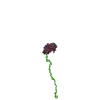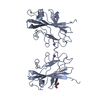+Search query
-Structure paper
| Title | The BR domain of PsrP interacts with extracellular DNA to promote bacterial aggregation; structural insights into pneumococcal biofilm formation. |
|---|---|
| Journal, issue, pages | Sci Rep, Vol. 6, Page 32371, Year 2016 |
| Publish date | Sep 1, 2016 |
 Authors Authors | Tim Schulte / Cecilia Mikaelsson / Audrey Beaussart / Alexey Kikhney / Maya Deshmukh / Sebastian Wolniak / Anuj Pathak / Christine Ebel / Jonas Löfling / Federico Fogolari / Birgitta Henriques-Normark / Yves F Dufrêne / Dmitri Svergun / Per-Åke Nygren / Adnane Achour /      |
| PubMed Abstract | The major human pathogen Streptococcus pneumoniae is a leading cause of disease and death worldwide. Pneumococcal biofilm formation within the nasopharynx leads to long-term colonization and ...The major human pathogen Streptococcus pneumoniae is a leading cause of disease and death worldwide. Pneumococcal biofilm formation within the nasopharynx leads to long-term colonization and persistence within the host. We have previously demonstrated that the capsular surface-associated pneumococcal serine rich repeat protein (PsrP), key factor for biofilm formation, binds to keratin-10 (KRT10) through its microbial surface component recognizing adhesive matrix molecule (MSCRAMM)-related globular binding region domain (BR187-385). Here, we show that BR187-385 also binds to DNA, as demonstrated by electrophoretic mobility shift assays and size exclusion chromatography. Further, heterologous expression of BR187-378 or the longer BR120-378 construct on the surface of a Gram-positive model host bacterium resulted in the formation of cellular aggregates that was significantly enhanced in the presence of DNA. Crystal structure analyses revealed the formation of BR187-385 homo-dimers via an intermolecular β-sheet, resulting in a positively charged concave surface, shaped to accommodate the acidic helical DNA structure. Furthermore, small angle X-ray scattering and circular dichroism studies indicate that the aggregate-enhancing N-terminal region of BR120-166 adopts an extended, non-globular structure. Altogether, our results suggest that PsrP adheres to extracellular DNA in the biofilm matrix and thus promotes pneumococcal biofilm formation. |
 External links External links |  Sci Rep / Sci Rep /  PubMed:27582320 / PubMed:27582320 /  PubMed Central PubMed Central |
| Methods | SAS (X-ray synchrotron) / X-ray diffraction |
| Resolution | 2.1 Å |
| Structure data |  SASDAC6:  SASDAE6:  PDB-5jui: |
| Chemicals |  ChemComp-NA:  ChemComp-GOL:  ChemComp-HOH: |
| Source |
|
 Keywords Keywords | STRUCTURAL PROTEIN / Streptococcus pneumoniae / Pneumococcal Serine Rich Repeat Protein / Oligomerisation / Bacterial aggregation / Biofilm formation / DNA |
 Movie
Movie Controller
Controller Structure viewers
Structure viewers About Yorodumi Papers
About Yorodumi Papers




